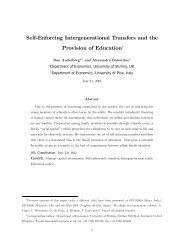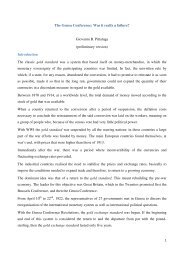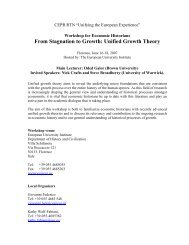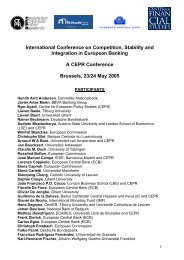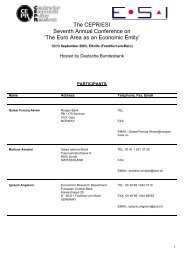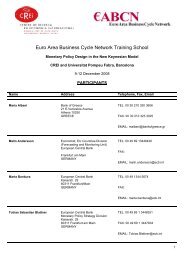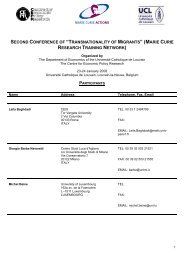MARKET STRUCTURE AND ENTRY: WHERE'S THE BEEF? - CEPR
MARKET STRUCTURE AND ENTRY: WHERE'S THE BEEF? - CEPR
MARKET STRUCTURE AND ENTRY: WHERE'S THE BEEF? - CEPR
Create successful ePaper yourself
Turn your PDF publications into a flip-book with our unique Google optimized e-Paper software.
1. INTRODUCTION<br />
The development of chain stores provides a natural context in which to examine some<br />
central questions relating to multi-product firms. In this paper, of particular interest is the<br />
old and central, but empirically unanswered, question of the identity of the entrant(s).<br />
Are we more likely to see the incumbent firm opening a new store than to see the entry of<br />
a new firm? Also, does existing-firm presence, of whatever type, deter entry?<br />
Importantly, traditional (Industrial Organization) models of entry usually exclude the<br />
effects of learning. The standard model of entry predicts that, all other things equal,<br />
when a firm has the choice between two otherwise identical markets, in one of which it<br />
would be the monopolist, in the other of which it would face some competition, the firm<br />
will choose the monopoly market. However, if the potential entrant can learn sufficient<br />
about the profitability of a market by observing the existing rival’s performance, is it<br />
possible that this strong prediction no longer holds true and may even be reversed?<br />
We attempt to answer these questions by empirically analyzing the development<br />
of market structures in the UK counter service burger industry. Our paper has major<br />
novelties in three areas. First, by estimating firm-specific profit functions we allow for<br />
product differentiation. Second, the possibility of learning is introduced. Third, the<br />
structural estimates we present later are unusual in their error structure.<br />
The UK counter service burger market over the time period 1991-1995 has<br />
features that make it a particularly attractive case to study. Firstly, the market is well<br />
defined in terms of the goods the firms produce, and the products are reasonably close<br />
substitutes. Secondly, due to the centralized operations of these firms, the locations and<br />
opening dates of outlets, their exact specifications, types of goods sold, and pricing<br />
policies are largely decided centrally and the outlets are reasonably homogeneous in type.<br />
1



